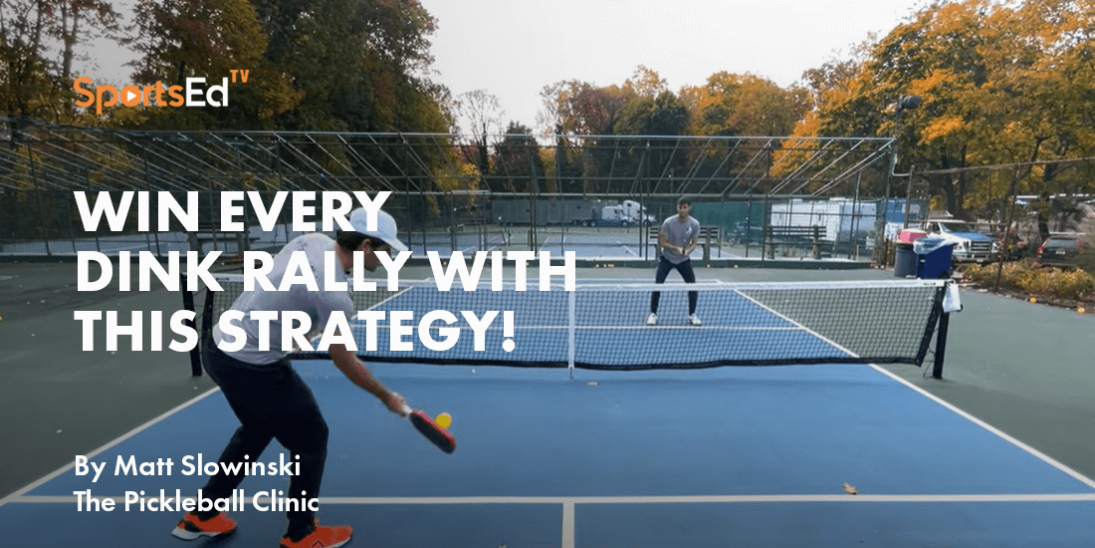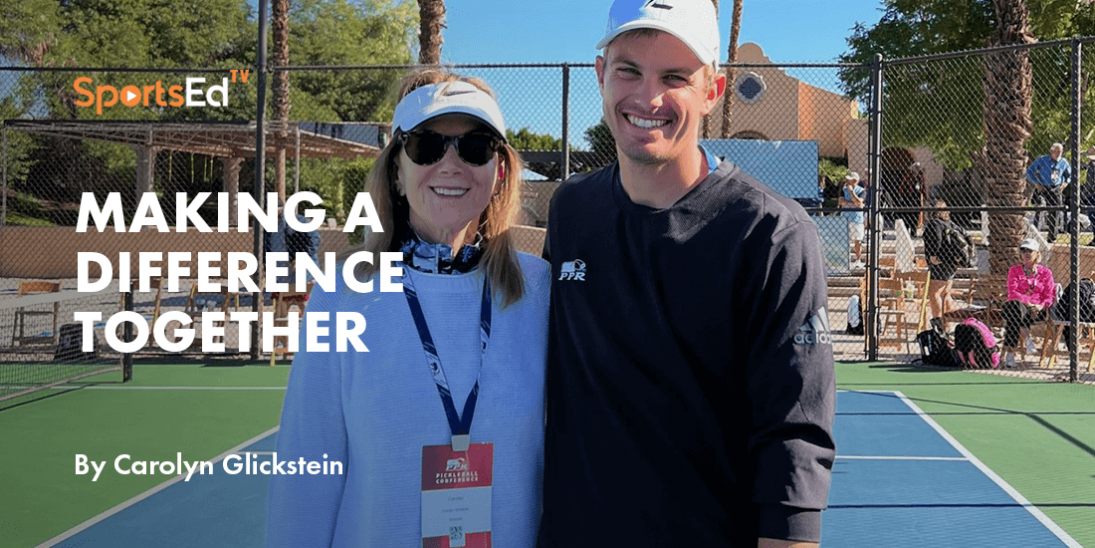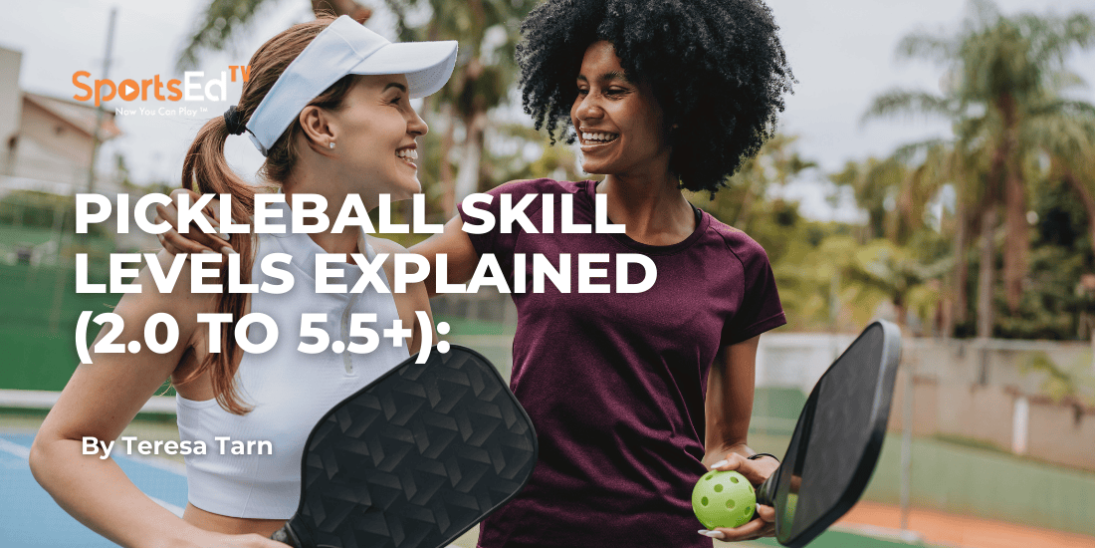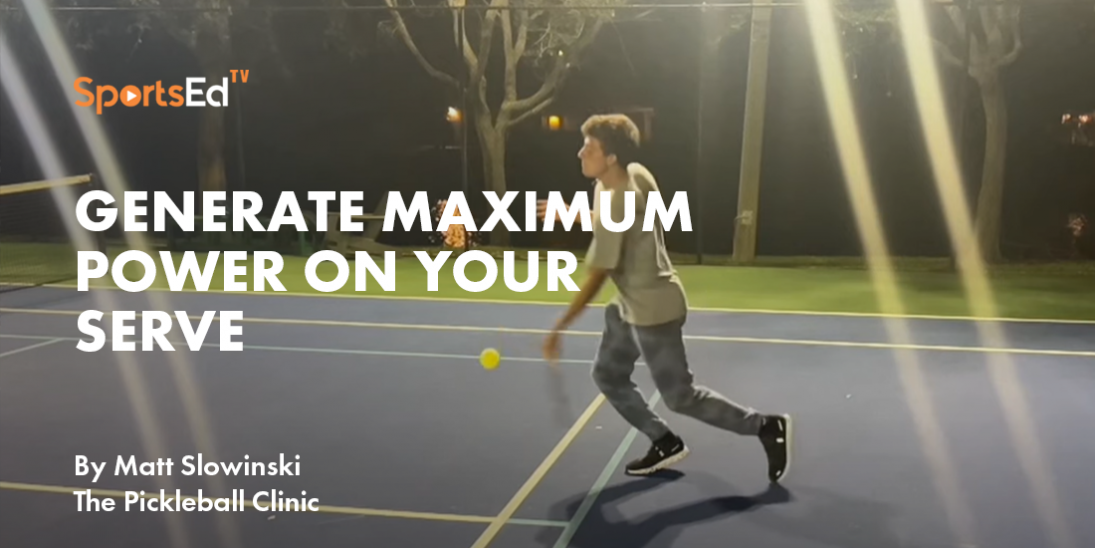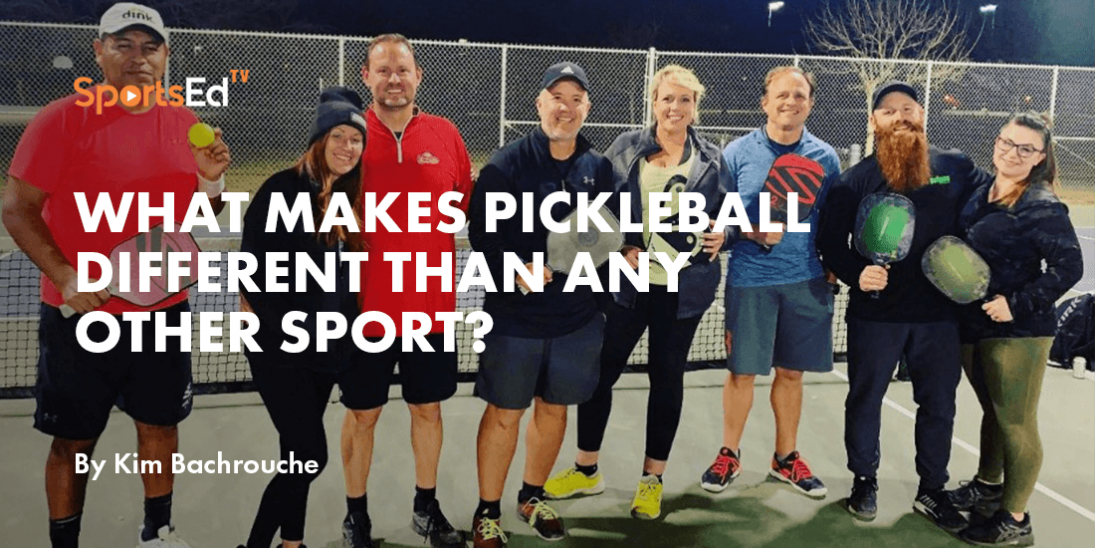Pickleball
Welcome and thanks for visiting...

Pickleball Rules - Ask The Refs
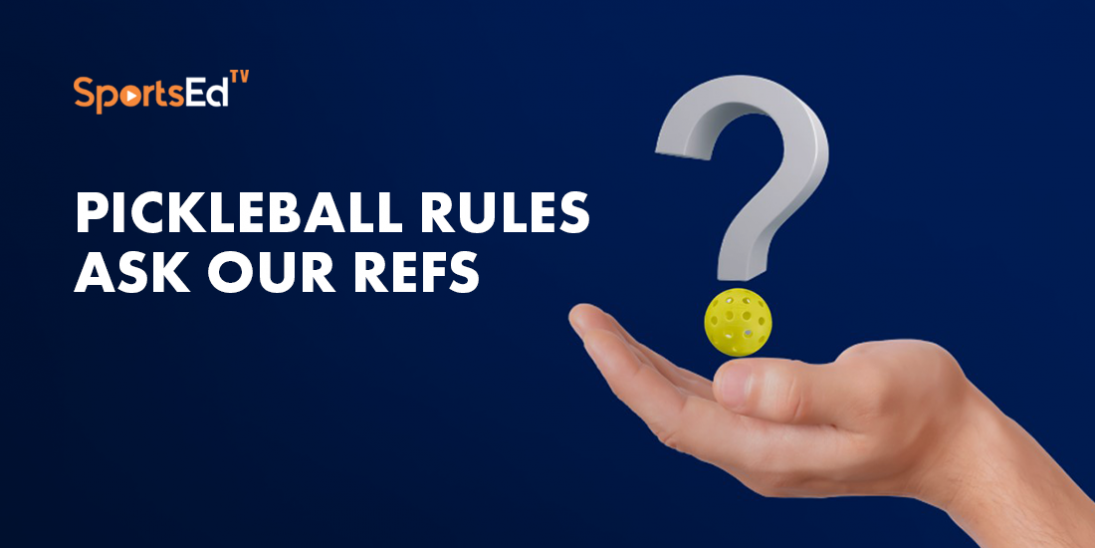
SportsEdTV’s blue ribbon pickleball referees answer rules questions posed by the pickleball community.
Our rules officiating team is APP Tour Head Referee Byron Freso and USA Pickleball Western Section Officiating leader Marsha Freso, both highly regarded for their pickleball officiating.
Rules questions should be submitted to askourref@sportsedtv.com. Weekly, the refs will answer a selected pair.
Pickleball Rules FAQs
Is it legal to double-hit the ball with your paddle?
11.A.Double Hits. Balls can be hit twice, but this must occur during an unintentional, continuous, single-direction stroke, by one player. If the stroke made while performing the serve or during a rally is deliberately not continuous, or not in a single direction or the ball is struck by a second player, it is a fault.
Who is right with line calling in pickleball?
I hit the ball deep (and was between the two opponents) which I thought hit the baseline…the two opponents look at each other and say “I didn’t see it, did you see it?” “no, I didn’t see it.” So I said, “well since I believe it hit the line and you both didn’t see it to dispute it, then it should be called in.” So then, one of the players says, “well then I’m calling it out now and since I was closer to where the ball landed, it’s out.” I’ve never seen a player first say he didn’t see it and then intentionally change his mind to win the point. Who’s right in this situation?
This is always an interesting dilemma for players when this scenario occurs. The answer is guided by USA Pickleball rules 6.D.3, 6.D.7, and 6.D.8. Since the players responsible for making the call did not see where the ball landed and therefore did not clearly see a space between the line and the ball, rendering them unable to make a prompt “out” call, they must give the benefit of any doubt to their opponents and consider the ball “in.”
6.D.3. The opponent gets the benefit of the doubt on line calls made. Any ball that cannot be called “out” will be considered “in.” A player cannot claim a replay because the ball was not seen or there is uncertainty. A player who does not make a call may appeal to the referee to make the call if they did not clearly see the ball land. If the referee is unable to make the call, the ball is “in.” The moment the receiving player/team appeals to the referee, they lose their right to make any subsequent "in" or "out" call for that rally.
6.D.7. Players shall not call a ball “out” unless they can clearly see a space between the line and the ball as it hits the ground.
6.D.8. All “out” calls must be made “promptly”; otherwise, the ball is presumed to still be in play. “Promptly” is defined as calling “out” prior to the ball being hit by the opponent or before the ball becomes dead.
Can I hit when in the kitchen?
This happened today. What is the right call?
A player hits the volley, but his partner hits the back of the paddle but does not touch the ball. The partner who hits the back of the paddle had a foot in the kitchen, what is the call?
This is a fault per USA Pickleball rule 9.B. since during the volley, the paddles are touching while the player’s partner‘s foot is in the non-volley zone.
9. B. It is a fault if the volleying player or anything that has contact with the volleying player while in the act of volleying touches the non-volley zone.
How do I know if the lines are in or out in pickleball?
The pickleball court lines are “in.” USA Pickleball rules 6.A, 6.B, and 6.C define “in” and “out” balls. Any ball in play that lands in the court or touches any court line is in, except the serve must clear the non-volley zone line and land in the correct service court to be good. If a ball lands outside the lines, it is “out.”
6.A. A served ball that clears the non-volley zone and lands in the correct service court or on any correct service court line is in.
6.B. Except the serve, any ball in play that lands in the court or touches any court line is in.
6.C. A ball contacting the playing surface completely outside of the court is “out”.
Where do I find out if there are any clothes prohibited in pickleball?
USA Pickleball rules relating to clothing are found in Section 2.G. Apparel. No specific clothing items or colors are prohibited other than shoes that mark or damage the playing surface. The Tournament Director can ban any garment that he/she judges as inappropriate for the tournament.
2.G.1. Safety and Distraction. A player may be required to change garments that are inappropriate.
2.G.2. Depictions. Graphics, insignias, pictures, and writing on apparel must be in good taste.
2.G.3. Footwear. Shoes must have soles that do not mark or damage the court’s playing surface.
2.G.4. Violation. The Tournament Director has the authority to enforce apparel changes. If the player refuses to comply with the apparel rules, the Tournament Director may declare a forfeit of the match.
What happens when a player, in pickleball, accidentally touches the net?
If a player touches the net during a rally, it is a fault against the player.
Section 7 - Fault Rules
A fault (and resulting dead ball) will be declared for the following:
7.G. A player, a player’s apparel, or a player’s paddle contacting the net system, the net posts, or the opponent’s court, when the ball is in play
What happens when a pickleball from a nearby court interferes with a game-deciding point?
When a stray pickleball interferes with a rally, a hinder is called and the rally is replayed. However, new in 2022, if an extra ball carried by a player during a self-officiated match drops on the court during a rally, it is a fault against that player.
3.A.15. Hinder – Any transient element or occurrence not caused by a player that adversely impacts play, not including permanent objects. Examples include, but are not limited to, balls, flying insects, foreign material, players or officials on another court that, in the opinion of the referee, impacted a player’s ability to make a play on the ball.
8.C. A hinder called by the referee or player will result in a dead ball. The referee will determine if the hinder called by the player was valid. A valid hinder will result in a replay.
7.N. In non-officiated matches, players may carry additional pickleball(s) as long as the ball(s) are carried in a way that the ball(s) are not visible to their opponent(s) during play. If an additional ball that a player was carrying falls on the playing surface during play, a fault shall be declared
What does it mean, in pickleball, that the head of the paddle must not be above the highest part of the wrist at contact in serving?
To start each rally in pickleball, an underhand serve is meant to be used. In the purest sense, when making an underhand serve, (1) the server’s arm moves in an upward direction upon the paddle contacting the ball and (2) the paddle head is below the server’s wrist. The third rule for the volley service motion, contacting the ball when it is below the server’s waist area, requires the ball to be hit upward to get it over the net and ensures an underhand motion is used for the serve.
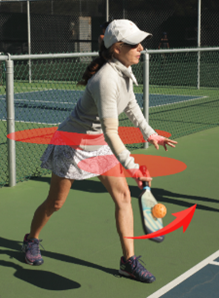
Photo and graphics courtesy of Steve Taylor, Digital Spatula
4.A.5.a. The server’s arm must be moving in an upward arc at the time the ball is struck and may be made with either a forehand or backhand motion.
4.A.5.b. The highest point of the paddle head must not be above the highest part of the wrist (where the wrist joint bends) when it strikes the ball.
4.A.5.c. Contact with the ball must not be made above the waist.
Where do I have to stand to serve in pickleball?
The server must stand behind the baseline of the correct service court, between the sideline and centerline, when serving.
4.A.4. The moment the ball is served:
4.A.4.a. At least one foot must be on the playing surface behind the baseline.
4.A.4.b. Neither of the server’s feet may touch the court on or inside the baseline.
4.A.4.c. Neither of the server’s feet may touch outside the imaginary extensions of the sideline or centerline.
Can I use a ping pong paddle to play pickleball?
A ping pong paddle is not a legal paddle to play pickleball with, so it cannot be used in a sanctioned tournament. However, it would make for an interesting game otherwise.
Where do I find out if it is OK to have loud music playing during pickleball games?
You should check with the facility manager to see if loud music is allowed to be played during games.
What is the most common rules mistake beginners make in pickleball?
Two common mistakes that beginners make are (1) forgetting to allow the ball to bounce after the serve is returned and (2) forgetting they cannot run to the net to hit the ball out of the air.
(Two-Bounce Rule) A fault (and resulting dead ball) will be declared for the following:
7.A. If the serve or service return does not bounce before the ball is struck.
9.A. All volleys must be initiated outside of the non-volley zone.
If the receiving player is off the court, e.g. beyond the baseline and the ball strikes their body prior to bouncing on the ground, is this a serving fault or a receiving fault?
This is the receiver's fault. The server gets a point.
4.N. Receiver Faults. It is a fault against the receiving team resulting in a point for the server if:
4.N.2. The receiver or their partner is touched by or interferes with the flight of the ball before it bounces.
When serving in doubles to your opponent cross-court, can his partner up at the NVZ try and distract the server by acting like he is going to jump in front of the serve or by just jumping around at the NVZ before the serve?
It’s not uncommon for pickleball to involve a bit of gamesmanship. Hopefully, when it’s used, it’s done in a fun, good-natured manner. The key to whether the jumping by the receiver’s partner would be called a distraction is how flagrant it was and when did it occur. In order to violate the distraction rule (11.J), the jumping would have to be notably distracting and take place just as the server is getting ready to hit the ball. It’s a judgment made by the referee at the time the action occurs based on the totality of the circumstances. To avoid the risk of being faulted, the receiver’s partner should refrain from the antics. There’s another risk for the receiver’s partner to consider by making himself a target: If the server hits the receiver’s partner with the ball on the fly, the server will win a point (4.N.2).
11.J. Distractions. Players may not distract an opponent when the opponent is about to play the ball. If in the judgment of the referee a distraction has occurred, the referee shall immediately call a fault on the offending team.
4.N. Receiver Faults. It is a fault against the receiving team resulting in a point for the server if:
4.N.2. The receiver or their partner is touched by or interferes with the ball's flight before it bounces.
What is going on with the confusion in the player community with the rule about called replays for perceived spinning serves?
Mostly it is about rule 4.a.9, which has been adjusted, but not as much as one would think. USA Pickleball Managing Director of Officials Mark Peifer thinks it is because the new rulebook has gone overboard in its efforts to communicate by publishing a graphic table explaining the rule, most of which existed previously. His full explanation can be found here.
Is it a fault if the serving person doesn’t say the score?
There is no penalty for failing to call the score before serving. For recreational play, if the score is not called, normally, either the server re-serves, calling the score before doing so, or the players agree to the score, and the score is called before the next rally ensues.
Rule 4.D.1 allows the server’s partner to call the score, for the duration of the game, in the event the server is unable to do so.
Whose point is it?
Player A and Player B are on opposite sides. Player A hits a volley from outside the Non-Volley Zone (NVZ) but starts teetering without yet falling into the NVZ. Player B hits the volley back from outside the NVZ but also starts teetering. Player B falls into the NVZ before Player A as part of the volley momentum. Player A then also falls into the NVZ as part of the volley momentum. Whose point is it?
When momentum is involved, faults are called in the order that the volleys were initiated. The player who volleyed first (Player A) is subject to fault first. Therefore, Player B wins the rally.




